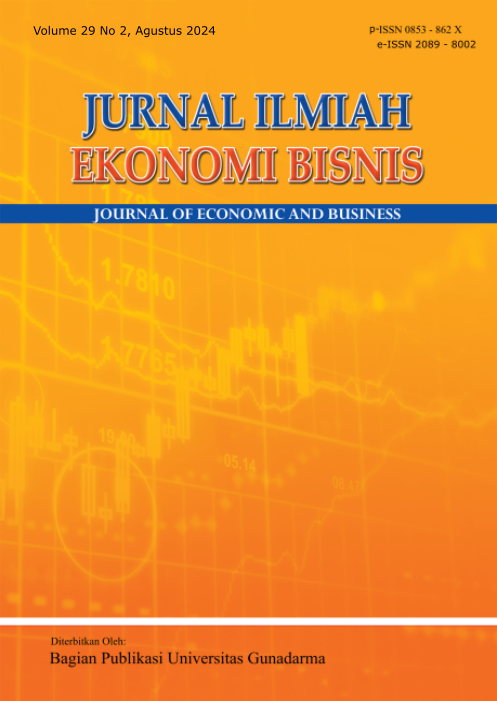STRATEGI KEUNGGULAN BERSAING UMKM BROWNMIX: INTEGRASI MEDIA SOSIAL DAN INOVASI PRODUK DALAM STUDI DESKRIPTIF
Universitas Jambi
Indonesia
Universitas Jambi
Indonesia
Universitas Jambi
Indonesia
Universitas Jambi
Indonesia
Universitas Jambi
Indonesia
Abstract
Penelitian ini mengungkap bagaimana media sosial dan inovasi produk menjadi kunci keunggulan bersaing bagi UMKM Brownmix. Dengan metode deskriptif, studi ini menggali pemanfaatan media sosial untuk pemasaran dan promosi, serta efek inovasi produk dalam diferensiasi pasar. Fokus khusus diberikan pada strategi media sosial Brownmix dalam menggaet audiens lebih luas, serta bagaimana inovasi produknya, termasuk ice cheesecake, memperkaya nilai tambah bisnis. Hasilnya menunjukkan kualitas produk superior, penggunaan efektif media sosial dalam branding, dan pelayanan pelanggan yang memuaskan, semua berkontribusi pada posisi kompetitif Brownmix di pasar.
Keywords
References
Ajina, A. S. (2019). The perceived value of social media marketing: An empirical study of online word of mouth in Saudi Arabian context. Entrepreneurship and Sustainability Issues, 6(3), 1512–1527. https://doi.org/10.9770/jesi.2019.6.3(32)
Ana, Kadarningsih. (2013). Pengaruh Strategi Diferensiasi Terhadap Upaya Membangun Keunggulan Bersaing Pada Hotel Alila Ubud, E-Jurnal Manajemen Unud, Vol. 6, No. 11, ISSN : 2302-8912. Anjaningrum, W. D. (2020). Efektivitas Digital Marketing Dan Networks Dalam Mendongkrak Kinerja
Pemasaran UKM Di Masa Pandemi Covid-19. SENABISMA: Seminar Nasional Administrasi Bisnis Dan Manajemen, 6(7), 50–61.
Appel, G., Grewal, L., Hadi, R., & Stephen, A. T. (2020). The future of social media in marketing. Journal of the Academy of Marketing Science, 48(1), 79–95. https://doi.org/10.1007/s11747-019-00695-1
Barney, J. B., & Clark, D. N. (2010). Gaining and Sustaining Competitive Advantage, Fourth Edition. Addison-Wesley, Massachusetts.
Cinelli, M., Quattrociocchi, W., Galeazzi, A., Valensise, C. M., Brugnoli, E., Schmidt, A. L., Zola, P., Zollo, F., & Scala, A. (2020). The COVID-19 social media infodemic. Scientific Reports, 10(1), 1–10. https://doi.org/10.1038/s41598-020-73510-5
Dahmiri, Indrawijaya, S., Fatricia, R. S., & Yasmin, A. (2018). Batik Jambi Promotion Based on Social
Media in Asean Economics Community. 1, 323–329. https://doi.org/10.1108/978-1-78756-793-1-00015
Damanpour, F. (1991). Organizational Innovation: A Meta-Analysis of Effects of Determinants and
Moderators. Academy of Management Journal, 34(3), 555–590. https://doi.org/10.1159/000192893
Ferreira, J., & Coelho, A. (2019). Dynamic capabilities , innovation and branding capabilities and their impact on competitive advantage and SME ’ s performance in Portugal : the moderating e ff ects of entrepreneurial orientation. https://doi.org/10.1108/IJIS-10-2018-0108
Gunelius, S. (2011). 30-Minutes SOCIAL MEDIA Marketing.
Hajli, N. (2015). Social commerce constructs and consumer’s intention to buy. International Journal of
Information Management, 35(2), 183–191. https://doi.org/10.1016/j.ijinfomgt.2014.12.005
Juditha, C. (2019). Agenda Setting Penyebaran Hoaks di Media Sosial. Jurnal Penelitian Komunikasi, 22(2),
–168. https://doi.org/10.20422/jpk.v22i2.669
Juju, D., & Sulianti, F. (2011). Hitam putih faceebook. Jakarta; PT Elex Media Komputindo.
Kaplan, A. M., & Haenlein, M. (2010). Users of the world, unite! The challenges and opportunities of Social
Media. Business Horizons, 53(1), 59–68. https://doi.org/10.1016/j.bushor.2009.09.003
Keltner, B. (1995). Relationship Banking and Competitive Advantage: Evidence From the U.S. and
Germany. California Management Review, 37(4), 45–72. https://doi.org/10.2307/41165810
Kotler, Armstrong, G., Ang, G. H., Leong, S. M., Tan, C. T., & Tse, D. . (2005). Principles of Marketing: An Asian Perspective. Pearson Prentice Hall, Singapore.
Kotler, Philip & Armstrong, Gary. (2010). Prinsip-prinsip Pemasaran. Edisi ke 12. Jilid 1. Jakarta : Penerbit Erlangga
Kotler, P., & Keller, K. L. (2012). Marketing Management,14th Edition. United States of America : Pearson.
Kriyantono, R. (2010). Teknik praktis riset komunikasi: disertai contoh praktis riset media, public relation, advertising, komunikasi organisasi, komunikasi pemasaran. Jakarta: Kencana.
Lestari, I., Astuti, M., & Ridwan, H. (2019). Pengaruh Inovasi Dan Orientasi Kewirausahaan Terhadap Keunggulan Bersaing Umkm Kuliner. Jurnal Riset Manajemen Dan Bisnis (JRMB) Fakultas Ekonomi UNIAT, 4(1), 111–118. https://doi.org/10.36226/jrmb.v4i1.245
Lukas, B. A., & Ferrell, O. C. (2000). The Effect of Market Orientation on Product Innovation. Journal of the Academy of Marketing Science, Volume 28, 239–247.
Machfoedz, M., & Machfoedz, M. (2004). kewirausahaan suatu pendekatan kontemporer. Unit penerbitan
dan percetakan akademi manaejemen perusahaan YKPN. Mayfield, A. (2008). What is Social Media?
McLean, G., & Osei-Frimpong, K. (2017). Examining satisfaction with the experience during a live chat service encounter-implications for website providers. Computers in Human Behavior, 76, 494–508. https://doi.org/10.1016/j.chb.2017.08.005
Nasrullah, R. (2015a). Media Sosial : Perspektif Komunikasi, Budaya dan Sosioteknologi. Simbiosa Rekatama Media.
Nasrullah, R. (2015b). Teori Dan Riset Media Siber (Cybermedia). Jakarta : Kencana Prenadamedia Group.
Nasrullah, R. (2017). Media Sosial : Perspektif Komunikasi, Budaya dan Sosioteknologi. Bandung : Simbiosa Rekatama Media.
OECD. (2005). Innovation to Strengthen Growth and Address Global and Social Challenges. Paris : OECD Publishing.
Pauwels, K., Silva-Risso, J., Srinivasan, S., & Hanssens, D. M. (2004). New products, sales promotions, and firm value: The case of the automobile industry. Journal of Marketing, 68(4), 142–156. https://doi.org/10.1509/jmkg.68.4.142.42724
Porter. (1980). Competitive Strategy: Techniques for Analyzing Industries and Competitors. New York: Free Press.
Prakosa, B. (2006). Pengaruh Orientasi Pasar, Inovasi Dan Orientasi Pembelajaran Terhadap Kinerja Perusahaan Untuk Mencapai Keunggulan Bersaing (Studi Empiris Pada Industri Manufaktur Di Semarang). Jurnal Studi Manajemen & Organisasi, 2(1), 35–57.
Puntoadi, D. (2011). Menciptakan Penjualan Melalui Media Social. PT. Gramedia Pustaka Utama.
Rainey, D. (2005). Product Innovation Leading Change through Integrated Product Development. Published in the United States of America by Cambridge University Press, New York.
Saiman, L. (2014). Kewirausahaan (Teori, Praktik, dan Kasus-kasus). edisi kedua. Salemba Empat, Jakarta. Siqueira, A. C. O., & Cosh, A. D. (2008). Effects of product innovation and organisational capabilities on competitive advantage: Evidence from UK small and medium manufacturing enterprises. International
Journal of Innovation Management, 12(2), 113–137. https://doi.org/10.1142/S1363919608001972
Sugiyono. (2018). Metode Penelitian Kuantitatif. Bandung : Alfabeta.
Tafesse, W., & Wien, A. (2018). Implementing social media marketing strategically: an empirical assessment. Journal of Marketing Management, 34(9–10), 732–749. https://doi.org/10.1080/0267257X.2018.1482365
Voorveld, H. A. M., van Noort, G., Muntinga, D. G., & Bronner, F. (2018). Engagement with Social Media and Social Media Advertising: The Differentiating Role of Platform Type. Journal of Advertising. 47(1), 38–54. https://doi.org/10.1080/00913367.2017.1405754
Profil Dosen: Dr. Drs. Syahmardi Yacob, MBA
Google Scholar : Dr. Drs. Syahmardi Yacob, MBA
Scopus : Dr. Drs. Syahmardi Yacob, MBA


